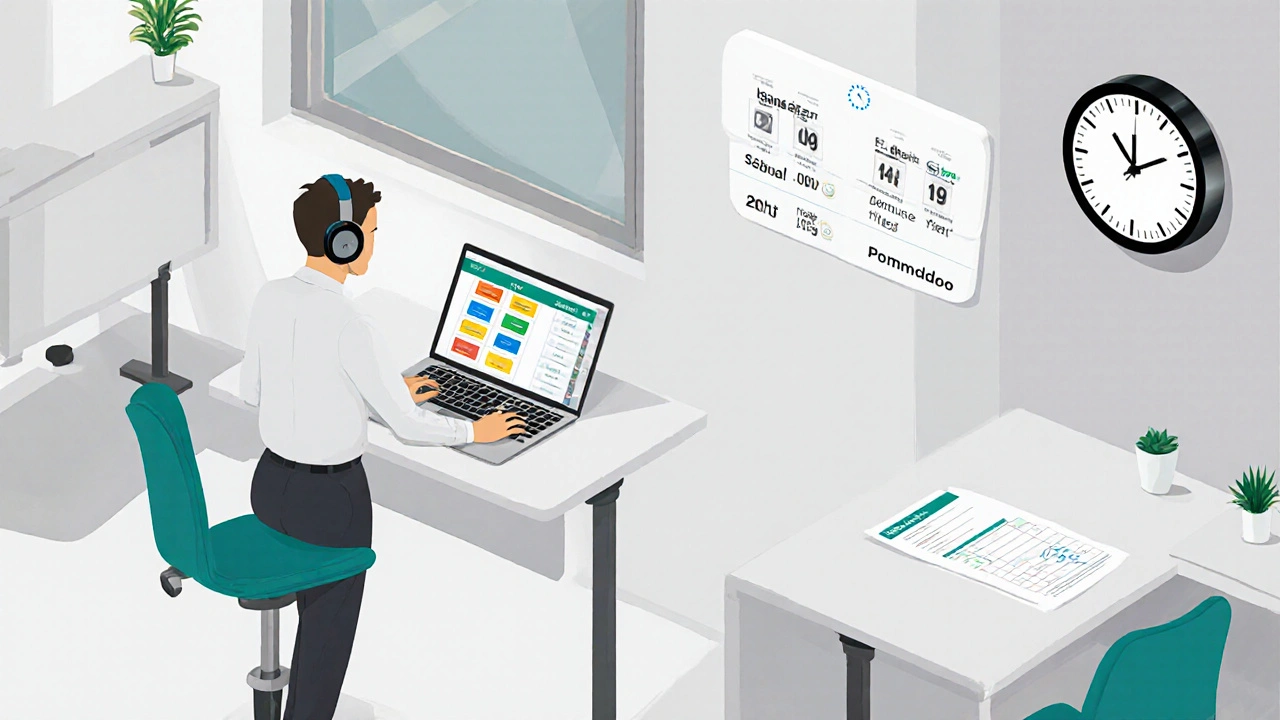ADHD Workplace Accommodation Matcher
Identify Your ADHD Challenges
Select symptoms you experience most at work to get personalized accommodation recommendations.
Your Recommended Accommodations
Based on your selected symptoms, these accommodations may help you thrive at work.
Physical Adjustments
Noise-cancelling headphones, standing desk
Primary benefit: Reduces sensory overload and restlessness
Scheduling Adjustments
Flexible start/end times, split-shift work
Primary benefit: Aligns peak focus periods with high-value tasks
Assistive Technology
Task-management apps, Pomodoro timers
Primary benefit: Structures work into manageable chunks
Communication Changes
Written summaries after meetings, clear deadlines
Primary benefit: Minimises mis-interpretation and forgetfulness
Tip: Many accommodations are protected under the Equality Act 2010. Start by discussing these with your manager as reasonable adjustments.
Living with Attention-Deficit Hyperactivity Disorder is a daily balancing act, and the workplace can feel like a high‑wire without a safety net. This guide breaks down what adult ADHD looks like on the job, which legal protections exist in the UK, and practical tweaks you or your manager can apply right now.
What Adult ADHD Actually Looks Like at Work
Adult ADHD differs from the childhood version mainly in how symptoms show up. Instead of constant fidgeting, an adult may experience:
- Difficulty staying focused during long meetings or on routine tasks.
- Impulsive decision‑making that can cause rushed emails or missed deadlines.
- Restlessness that drives a need to switch between projects.
- Forgetfulness around deadlines, appointments, or where items were placed.
These patterns don’t mean the person is lazy; they’re a direct result of how the brain processes attention and executive function. Recognising the symptoms is the first step toward easing their impact.
Legal Backbone: The Equality Act 2010
In England, Scotland, Wales and Northern Ireland, the Equality Act 2010 requires employers to make reasonable adjustments for employees with a disability, which includes ADHD when it has a substantial and long‑term effect on day‑to‑day activities. This means you have a right to request accommodations without fear of retaliation.
Reasonable adjustments are not a one‑size‑fits‑all. They must be practical, proportionate and tailored to the employee’s needs. Typical requests include flexible hours, a quieter workspace, or assistive software.
Top Workplace Accommodations That Make a Difference
Below is a quick‑look comparison of the most common accommodation categories. Use it to decide what fits your role and environment best.
| Category | Typical Example | Primary Benefit | Implementation Ease |
|---|---|---|---|
| Physical Adjustments | Noise‑cancelling headphones, standing desk | Reduces sensory overload and restlessness | Low - often a one‑time purchase |
| Scheduling Adjustments | Flexible start/end times, split‑shift work | Aligns peak focus periods with high‑value tasks | Medium - requires manager approval |
| Assistive Technology | Task‑management apps, Pomodoro timers | Structures work into manageable chunks | Low - many free or low‑cost tools |
| Communication Changes | Written summaries after meetings, clear deadlines | Minimises mis‑interpretation and forgetfulness | Medium - needs habit formation |
Pick one or two from each column to build a support package that feels doable for both you and your employer.

Assistive Technology You Can Start Using Today
Technology is a game‑changer for many adults with ADHD. Below are three tools that map directly to everyday challenges.
- Task‑management apps like Todoist or Microsoft ToDo let you break projects into sub‑tasks, assign due dates, and set priority tags.
- Pomodoro Technique - work for 25 minutes, then take a 5‑minute break. Apps such as Focus Keeper automate the timer and provide visual progress.
- Noise‑cancelling headphones block distracting background chatter and create a personal “focus bubble”.
When you pair these tools with the right environment, you’ll notice a drop in overwhelm and a rise in completed work.
Coping Mechanisms Beyond the Desk
Accommodation helps, but personal coping strategies cement lasting change. Here are evidence‑based habits that work for many adults with ADHD.
- Structured routines: Start each day with a short planning session. Write down three priority items and the order you’ll tackle them.
- Mindfulness breaks: A 2‑minute breathing exercise can reset attention and lower impulsivity. Apps like Headspace have short guided sessions.
- Physical activity: Short walks or a quick set of jumping jacks boost dopamine, which helps with focus.
- Cognitive Behavioral Therapy (CBT): Cognitive Behavioral Therapy targets maladaptive thought patterns and builds practical skills for organization and emotional regulation. A therapist experienced with ADHD can tailor exercises to workplace scenarios.
- Medication: Stimulants like Methylphenidate increase dopamine and norepinephrine activity, improving attention and impulse control for many adults. Discuss dosage and side‑effects with a GP or psychiatrist to find the best fit.
Combine at least one therapeutic habit with the accommodations above for a balanced approach.
How Managers Can Support Their ADHD Team Members
Support works best when it’s a two‑way conversation. Managers should aim to:
- Ask open‑ended questions: “What tools or tweaks help you stay on track?”
- Offer clear, written instructions after verbal briefings.
- Set realistic deadlines and break large projects into milestones.
- Provide a quiet workspace or permission to use noise‑cancelling headphones.
- Encourage regular check‑ins to monitor progress and adjust accommodations as needed.
When managers demonstrate flexibility, they boost morale and productivity across the entire team.

Self‑Advocacy Checklist for Employees
- Identify your biggest workplace challenges (focus, memory, impulsivity).
- Document specific examples - dates, tasks, outcomes.
- Research which adjustments are reasonable under the Equality Act 2010.
- Schedule a meeting with your line manager and present a concise request (e.g., “I’d like to try a flexible start time from 9am to 5pm”).
- Follow up in writing and keep a copy of any agreement.
- Monitor the impact for a month, then tweak the plan if needed.
Having a written record protects both you and your employer and makes future conversations smoother.
Quick Reference: Accommodation & Coping Summary
- Physical: Noise‑cancelling headphones, ergonomic chair.
- Scheduling: Flexible hours, split shifts.
- Tech: Task apps, Pomodoro timers.
- Communication: Written briefs, clear deadlines.
- Personal: Daily planning, short mindfulness breaks, regular exercise.
- Professional: CBT with an ADHD‑trained therapist, medication under medical supervision.
Mix and match based on what feels most doable right now. Small changes add up quickly.
Frequently Asked Questions
Is ADHD considered a disability under the Equality Act?
Yes, if ADHD has a substantial and long‑term effect on daily activities, it is protected as a disability. This gives you the right to request reasonable adjustments at work.
What is the fastest way to improve focus during a meeting?
Ask for a short written summary after the meeting and use a noise‑cancelling headset during the session. Pair this with a quick note‑taking habit to capture key points.
Can I request a flexible start time if I’m not on a formal disability plan?
You can still request flexible hours. While the Equality Act provides stronger grounds for a request, many employers are open to trial arrangements that boost productivity.
How often should medication be reviewed?
Typically every three to six months, or sooner if side‑effects appear. Your GP or psychiatrist will adjust dosage based on symptom control and tolerability.
Is CBT covered by the NHS for adult ADHD?
Yes, many NHS trusts offer CBT for ADHD, though wait times can be long. Private therapists may provide quicker access if you can cover the cost.


Jonathan Mbulakey
October 12, 2025 AT 16:43When you step back and look at ADHD through a philosophical lens, it becomes less of a flaw and more of a different wiring of attention. The mind’s tendency to hop between ideas can actually fuel creativity if the environment allows it. In a workplace that values linear processing, that same trait feels like a liability. Recognising the pattern is the first step toward shaping accommodations that respect the brain’s natural rhythm. So think of adjustments not as fixes, but as bridges between divergent cognition and corporate expectations.
Warren Neufeld
October 16, 2025 AT 02:43I totally get how hard it can be to stay on track during long meetings. Using a simple checklist on your phone can keep you focused on the main points. Pair that with a quick note after the meeting, and you’ll remember the action items better. Small tools like this make a big difference without needing a massive overhaul.
Deborah Escobedo
October 19, 2025 AT 12:43Try a short written summary after each meeting to lock in the key points.
Dipankar Kumar Mitra
October 22, 2025 AT 22:43Imagine your brain as a restless river, forever seeking a new channel to flow. In the office, that river often bumps into concrete walls of endless spreadsheets and endless Zoom calls. The solution isn’t to dam that water but to carve a channel that guides it productively. Noise‑cancelling headphones act like a dam, reducing the roar of the office while you concentrate. Flexible hours are the levees that let you work when the current is strongest. Pomodoro timers are the rocks that break the flow into manageable cascades. When you combine physical, temporal, and tech adjustments, the river finds its own path without flooding the workplace. Embrace the chaos and shape it, rather than fighting it.
Tracy Daniels
October 26, 2025 AT 07:43One of the most inclusive ways to support colleagues with ADHD is to standardise written briefings after verbal discussions 😊. This habit cuts down on memory gaps and ensures everyone has the same reference point. Pair the brief with clear deadlines and you’ll see fewer missed deliverables. Encourage the use of task‑management apps that allow visual tracking of progress. Finally, remind managers that reasonable adjustments are not perks but legal rights, and they foster a healthier team dynamic.
David Bui
October 29, 2025 AT 17:43While your suggestions are nice, most people ignore written briefs and just rely on memory. The reality is that without strict enforcement, these “inclusive” practices fall flat. You need a system that actually audits compliance, not just a suggestion box.
Alex V
November 2, 2025 AT 03:43Oh sure, because the universe loves audit trails more than it loves actual productivity. The next time we’ll all be chained to spreadsheets to prove we sent an email, right?
Robert Jackson
November 5, 2025 AT 13:43From a national perspective, it’s clear that many workplaces still view ADHD through a stigma‑laden lens, as if it’s a personal failing rather than a neurodivergent condition.
Sriram Musk
November 8, 2025 AT 23:43While I understand the sentiment, the law in the UK already mandates reasonable adjustments, so framing it as a national issue may miss the point that many employers are already complying.
allison hill
November 12, 2025 AT 09:43Actually, the compliance statistics are far worse than you think; many firms claim to follow the Equality Act but fail to implement concrete measures, leading to a facade of inclusion.
Tushar Agarwal
November 15, 2025 AT 19:43Just a quick heads‑up: using a simple timer app like Focus Keeper can really help break the day into bite‑size chunks, making it easier to stay on task 😊.
Richard Leonhardt
November 19, 2025 AT 05:43Great tip! Adding a visual cue like a bright coloured timer also signals to coworkers that you’re in a focused mode and shouldn’t be disturbed.
Shaun Brown
November 22, 2025 AT 15:43First, let me point out that the very notion of “visual cues” being a panacea for ADHD in the workplace is a gross oversimplification that ignores the underlying neurochemical realities. The brain’s dopamine regulation does not magically align with the flicker of a coloured timer; instead, it requires a comprehensive strategy that includes medication, behavioural therapy, and environmental engineering. Second, relying on external symbols places the burden of disclosure on the employee, effectively forcing them to flag their condition in a way that can be weaponised in office politics. Third, many managers misinterpret these cues as a request for leniency rather than a legitimate accommodation, thereby perpetuating bias. Fourth, the data from large‑scale occupational health studies demonstrate that short‑term fixes like timers only marginally improve task completion rates, often by less than five percent. Fifth, the long‑term impact on career progression is negligible unless paired with structural changes such as flexible hours and workload redistribution. Sixth, let’s not forget that the legal framework-specifically the Equality Act-requires reasonable adjustments that extend far beyond a simple desk accessory. Seventh, the emphasis on “visual” solutions also neglects auditory processing disorders that co‑occur with ADHD, which may actually benefit more from sound‑masking technologies. Eighth, workplaces that truly invest in assistive technologies report higher employee retention and reduced sick‑leave, a fact that many profit‑driven firms conveniently overlook. Ninth, the culture of “just try harder” is a toxic narrative that fuels stigma and discourages disclosure. Tenth, when employees feel forced to adopt superficial tools, they may experience increased anxiety, feeling watched and judged. Eleventh, the argument that timers are harmless ignores the potential for creating a surveillant environment reminiscent of a panopticon. Twelfth, the cumulative effect of these misguided policies is a workforce that is under‑utilised and demotivated. Thirteenth, real change demands a partnership between HR, line managers, and the employee, with clear documentation and regular reviews. Fourteenth, any organization claiming to support neurodiversity must audit its practices and publish transparent outcomes. Fifteenth, until these systemic issues are addressed, any emphasis on “colourful timers” remains a superficial Band‑Aid that does little to resolve the core challenges faced by adults with ADHD in professional settings.